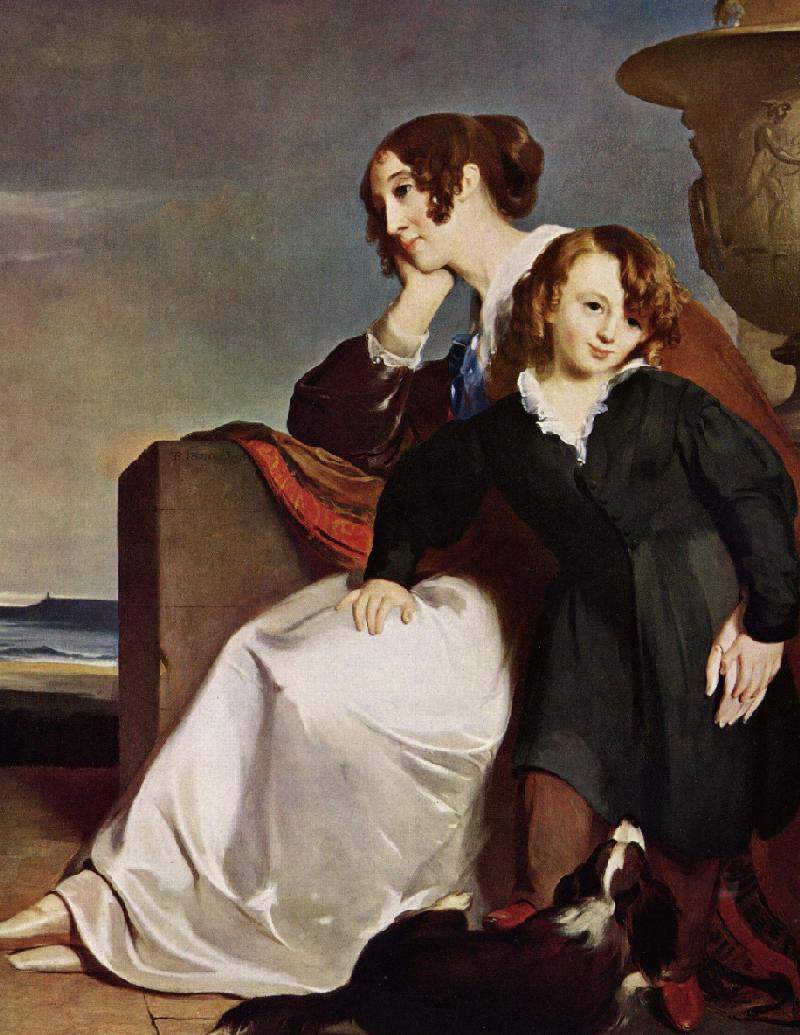
Thomas Sully: Portraits

Figure 1.--Here is a family portrait by Sully. The individuals are his daughter Jane Sully Darley (1807–77) and her son Francis Thomas Sully Darley (1834?-1914). He looks to be about 5-6 years old.
By this time the Sullys and her husband were an established paet of Philadelphia society. The portrait is usually dated 1840, but was painted in 1839. It has been compared to Thomas Lawrence's "Countess Grey and Her Daughters". Lawrence was a major influence in Sully's work. Francis wears an open neck blouse rather like Byron and the image has a Greek look to it--even without the Greek planter. I am not sure how common this was at the time. The tunic and long trousers probably was more common. Notice the boy's ringlets. We don't think they were very common for a boy Francis' age, but remember he came from a well-to-do, stylish Philadelphia family. Internet images of paintings can vary in color. We have seen scans showing a much brighter green.
|
|
Sully is best known for his portraits. He studied under Gilbert Stuart, Benjamin West, and Thomas Lawrence--quite an imprwesive group. He became the most aclaimed portratist of his day. This painting here was "Mother and Son", painted in 1829. It is typical of his rather romantasised portraits that he did early in his career. At the time, Sully was disappointed with his career and not gaining the lucrative commossions he had anticiated. He was thinking about closing his studio. Afew years later he painted John Quincey Adams just before he became president (1824). This made a name for him and he was soon receiving the lucrative commions he had invisdioned, including some of the most importnt individuals of antebellum America. asmp As a result, is work is of great historical importance. At the time, the Marquis de Lafayette (a hero of the Revolution) was visiting America. He even painted a young Queen Victoria on a trip to England (1837–38). He also painted Thomas Jefferson. There are fewer portraits of children, but the ones painted before 1840 provide an important record of how children dressed in the years before photography. The portrait here, "Mother and Son" is probably not the best example of how American boys dressed in the 1830s. It represents not only a well-to-do family in what was still the most fashionable city in America at the time (Philadelphia). New York did not begin to emerge as America's major city until well after the Erie Canal was completed (1825). Not only did they live in a fashionable city, but they were a very artitic family, involved in both art and music. The paiting is almost a paeon to Byron. We believe the open, frilled collar was not very common in 1839, although they were more commonly worn earlier. The tunic and long pants were probably more representative.
HBC

Navigate the HBC Art pages:
[Return to the Main Sully page]
[Return to the Main individual artist S-Z page]
[Return to the Main American artist page]
[Chronology]
[Country]
[Individual Artists]
[Styles]
Navigate related Boys' Historical Clothing Web Site pages:
[Main style page]
[Hair styles]
[Collar bows]
[Dresses]
[Blouse]
[Kilt suits]
[Kilts]
[Tunics]
[Sailor dresses]
[Pinafores]
[Smocks]
[Curls]
Navigate the Historical Boys Clothing Web Site:
[Introduction]
[Activities]
[Bibliographies]
[Biographies]
[Chronology]
[Clothing styles]
[Countries]
[Contributions]
[FAQs]
[Glossaries]
[Images]
[Links]
[Registration]
[Tools]
[Boys' Clothing Home]
Created: 10:57 PM 5/23/2010
Last updated: 10:57 PM 5/23/2010



